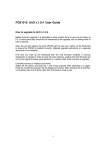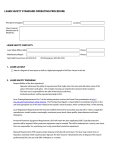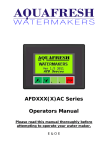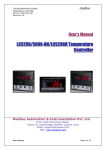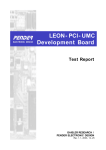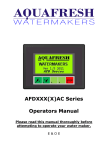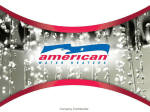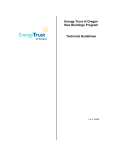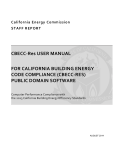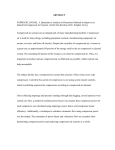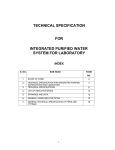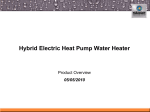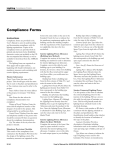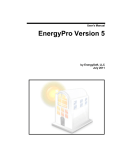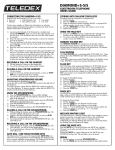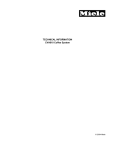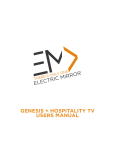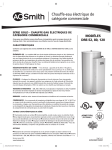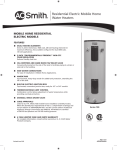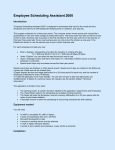Download Compliance Forms
Transcript
Compliance Forms HVAC Compliance Forms Compliance forms are provided in the User’s Manual to assist in understanding and documenting compliance with the HVAC requirements. Copies of the forms are provided both in printed and electronic form. Modifiable electronic forms are included on the CD distributed with the Manual, as well as available for download from the ASHRAE website. The HVAC system forms are organized in three parts and on five pages. ▪ Part I is used with the Simplified Approach Option (§ 6.3). This is the only form required with this compliance option. ▪ Part II, the Mandatory Provisions, consists of two pages and should be used with either the Prescriptive Path (§ 6.5) or Energy Cost Budget (§ 11) compliance methods. The first page contains header information, tables for entering equipment efficiencies for heating and cooling equipment, and checklists of general and special mandatory requirements. The second page contains the HVAC System Worksheet. Multiple copies of each page may be required to list all central heating and cooling equipment and all HVAC systems. ▪ Part III should only be used for the Prescriptive Path (§ 6.5) compliance method. Page one is a checklist of the prescriptive requirements and needs to be completed only once for each building. Page two addresses the fan power requirements. Part I: Simplified Approach This compliance approach may be used for small buildings with two or fewer floors and single, zone systems. Header Information Project Name. Enter the name of the project. This should agree with the name that is used on the plans and specifications or the common name used to refer to the project. Project Address. Enter the street address of the project, for instance “142 Minna Street." Date: Enter the date when the compliance documentation was completed. City: The name of the city where the project is located. Zip/Postal Code: Enter the zip or postal code of the project site. HVAC Designer of Record/Telephone: Enter the name and the telephone number of the designer of record for the project. This will generally be the mechanical engineer or contractor. Contact Person/Telephone: Enter the name and telephone number of the person who should be contacted if there are questions about the compliance documentation. Checklist Qualification Only small buildings less than 25,000 ft² and with two or fewer stories may use the Simplified Approach. Requirements This section of the form summarizes the Simplified Approach requirements. Each form is separated into two sections. The upper part of the form contains a list of the requirements. Check each box to indicate that the requirement applies to the HVAC system and that the system complies with the requirement. If the requirement is not applicable, then leave the box unchecked. The lower part of the form contains a table for entering heating and cooling capacities and efficiencies for comparison against the Standard. The rated capacity and efficiency for heating and cooling should be taken from manufacturers specifications. User’s Manual for ANSI/ASHRAE/IESNA Standard 90.1-2004 The Minimum Efficiency columns should include values taken from Tables 6.8.1 and 6.3.2. The last column “Econ. Min. Efficiency” need only be completed if an exception to the economizer requirement is being taken, based on greater equipment efficiency (See Table 6.3.2). Part II: Mandatory Provisions This section of the compliance documentation summarizes the Mandatory Provisions. These apply with either the Prescriptive Path or Energy Cost Budget Method of compliance. The two pages of mandatory requirements are organized into three sections: ▪ The efficiency tables on Page 1 document that heating and cooling equipment meets or exceeds the efficiency requirements. ▪ The check boxes in the lower part of Page 1 demonstrate compliance with the general and special provisions of the Mandatory Provisions. ▪ The Systems Worksheet on Page 2 summarizes the requirements specific to air-handling systems. Equipment Efficiency Tables Enter the requested data for each piece of mechanical heating or cooling equipment using one entry per row. Identical pieces of equipment can be entered as a group on a single line. For each row, enter data from the mechanical equipment schedules and Tables 6.8.1 (A through G). For each row, enter data from the mechanical equipment schedules and Tables 6.2.1 (H through J). Non-standard chillers are water-cooled centrifugal chillers that cannot operate at the ARI Standard 550/590 test conditions of 44°F chilled water supply and 85°F condenser water supply. Use the lower 6-79 HVAC Compliance Forms worksheet for these chillers (if any exist in the building). General and Specific Mandatory Provisions The lower part of the Page 1 form contains the general and special system requirements. Check the box to indicate that the requirement applies to the HVAC system and that the system complies with the requirement. If the requirement is not applicable, then leave the box unchecked. Systems Worksheet Page 2 contains the mandatory requirements for HVAC systems. Data for each system or group of identical systems should be entered in the columns. The first five rows are data that can be obtained from the mechanical equipment schedules (system tag, supply airflow, supply external static pressure, supply fan motor rated horsepower, and outdoor air airflow). The remaining 11 rows contain the mandatory requirements. For each requirement enter the appropriate code from the notes below the table. For example, for the Automatic Shutdown requirement (§ 6.4.3.2.1), if a complying time switch with manual override is provided on the system the user should enter the code “C1.” Part III: Prescriptive Requirements This section of the compliance documentation summarizes the prescriptive requirements. The first page has a checklist of the prescriptive requirements. Prescriptive Economizer Requirements Check all of the boxes that apply for HVAC systems in this project. Note: if systems are exempt from the economizer 6-80 requirement, mark the basis for the exception in the space provided. If a requirement is not applicable, then leave the box unchecked. Prescriptive Air-System Requirements The next section contains the air-system requirements. Check all of the boxes that apply to HVAC systems in this project. If a requirement is not applicable, then leave the box unchecked. Prescriptive Water-System Requirements The next section contains the watersystem requirements. Check all of the boxes that apply to HVAC systems in this project. If a requirement is not applicable, then leave the box unchecked. Prescriptive Special System Requirements Check all of the boxes that apply to HVAC systems in this project. If a requirement is not applicable, then leave the box unchecked. If none of the requirements are applicable, the form may be omitted. horsepower for all the rows in the boxes, the table, and in the worksheet where indicated by the arrows. The first value in the worksheet is entered from Table 6.5.3.1 in the Standard. This value depends on the total supply airflow and the type of system (constant volume or variable volume). The total system horsepower allowance is calculated from the following equation: HP Allowance (6-H) Table 6.5.3.1Value Total Supply Airflow 1,000 There are corrections for the horsepower allowance for low temperature supply, high pressure filters, pressure drop for evaporative cooling or heat recovery equipment, and relief fans that operate during peak cooling. To use these corrections, the user must attach calculations using the equations from § 6.5.3.1 of the Standard. Fan Power Limitations Fill out the worksheet on Page 2 for each fan system with greater than 5 nameplaterated horsepower. Groups of identical systems may be combined into a single worksheet. The table has 10 columns. The first three are for the tag, supply airflow and nameplate-rated horsepower for each of the supply fans in the system. There are two columns each for the tag and nameplate rated horsepower for the return and exhaust fans and a pair for each of the series-style fan-powered boxes (if appropriate). Sum the motor horsepower for each row and enter the total in the “total system motor (hp)” column on the far right. Enter the sum of the supply fan airflow and total system motor User’s Manual for ANSI/ASHRAE/IESNA Standard 90.1-2004 HVAC Simplified Approach Option Part I Project Name: Project Address: Date: City: Zip: HVAC System Designer of Record: Telephone: Contact Person: Telephone: Qualification The building is 2 stories or less in height and 2 has a gross floor area is less than 25,000 ft . Requirements (a) All systems serve a single HVAC zone. (b) Cooling (if any) is provided by a unitary packaged or split-system air conditioner that is either air-cooled or evaporatively cooled and meets the efficiency requirements shown in Table 6.8.1. List equipment in the table below. (c) The system has an air economizer as required by Table 6.5.1, with controls as required in Tables 6.5.1.1.3A and 6.5.1.1.3B. The economizer has either barometric or powered relief sized to prevent overpressurization of the building. Outdoor air dampers for the economizer use are provided with blade and jamb seals. Exception: The cooling efficiency meets or exceeds the efficiency requirement in Table 6.3.2. Document in table below. (d) Heating (if any) shall be provided by a unitary packaged or split-system heat pump, a fuel-fired furnace, an electric resistance heater or a baseboard system connected to a boiler. All heating equipment meets the efficiency requirements of the Standard. List equipment in table below. Exception: An energy recovery ventilation system is provided in accordance with the requirements in § 6.5.6. (f) The system shall be controlled by a manual changeover or dual setpoint thermostat. (g) Heat pumps equipped with auxiliary internal electric resistance heaters (if any) have controls to prevent supplemental heater operation when the heating load can be met by the heat pump alone. (h) The system controls do not permit reheat or any other form of simultaneous heating and cooling for humidity control. (i) Systems are provided with a time switch that (1) can start and stop the system under different schedules for seven different daytypes per week; (2) is capable of retaining programming and time setting during a loss of power for a period of at least 10 h; (3) includes an accessible manual override that allows temporary operation of the system for up to 2 h; (4) is capable of temperature setback down to 55 F during off hours; and (5) is capable of temperature setup to 90 F during off hours. Exception: System serves hotel/motel guest rooms. Exception: Piping is located within manufactured HVAC units. (k) Ductwork and plenums are insulated in accordance with Tables 6.8.2A and 6.8.2B and sealed in accordance with Tables 6.4.4.2A and 6.4.4.2B. (l) Construction documents require air systems to be balanced in accordance with industry-accepted procedures to within 10% of design airflow rates. (m) Where separate heating and cooling equipment serve the same temperature zone, thermostats are interlocked to prevent simultaneous heating and cooling. (n) Exhausts are equipped with gravity or motorized dampers that will automatically shut when systems are not in use. Exception: System operates continuously. Exception: Design capacity is less than 300 cfm. Exception: System operates continuously. (o) Systems have optimum start controls. Exception: System has both a cooling or heating capacity less than 15,000 Btu/h and a supply fan motor power greater than 3/4 hp. (e) The outdoor air quantity is less than or equal to 3,000 cfm and less than or 70% of the supply air quantity at minimum outdoor air design conditions. (j) Piping is insulated in accordance with Table 6.8.3. Insulation exposed to weather is suitable for outdoor service. Cellular foam insulation is protected from water and solar radiation. Exception: Supply air capacity is less than 10,000 cfm. Equipment Efficiency System Tag(s) Mfg. & Model No. Equipment Type Heating Rated Capacity ANSI/ASHRAE/IESNA Standard 90.1-2004 Rated Efficiency Cooling Minimum Efficiency Rated Capacity Rated Efficiency Minimum Efficiency Econ. Min. Efficiency HVAC Mandatory Provisions Part II, Page 1 Project Name: Project Address: Date: HVAC System Designer of Record: Telephone: Contact Person: Telephone: City: Climate Zone: Zip: 1% Summer DB Temp: 1% Summer WB Temp: 99.6% Winter Temp: Mandatory Equipment Efficiency Worksheet (§ 6.4.1.1) System Tag Equipment Type (Tables 6.8.1A through G) Size Category (Tables 6.8.1A through G) Sub-Category or Rating Condition (Tables 6.8.1A through G) Units of Efficiency (Tables 6.8.1A through G) Minimum Efficiency (Tables 6.8.1A through G) Rated Required Mandatory Non-Standard Centrifugal Chiller Worksheet (§ 6.4.1.1) System Tag Leaving CHW Temperature (°F) Entering CW Temperature (°F) Condenser Flow Rate (gpm/ton) Size Category (Tables 6.8.1H through J) Minimum Efficiency (Tables 6.8.1H through J) Rated General Mandatory Requirements Load calculations are provided for selection of all equipment and systems (§ 6.4.2). Stair vents, elevator shaft vents, gravity hoods, gravity vents and gravity ventilations are provided with motorized dampers. Exception: Gravity dampers are used since the building is less than 3 stories or in climate zones 1–3. Exception: No vents are required as these systems ventilate unconditioned zones. ANSI/ASHRAE/IESNA Standard 90.1-2004 Piping insulation meets or exceeds the requirements of the Standard (§ 6.4.4.1.3). Construction documents require record drawings (§ 6.7.2.1), manuals (§ 6.7.2.2), system balancing (§ 6.7.2.3) and system commissioning (§ 6.7.2.4). Required Special Mandatory Requirements Freeze protection or snow/ice melting systems (if any) have controls to prevent operation in warm weather (§ 6.4.3.7). Independent perimeter heating systems (if any) comply with the control requirements of § 6.4.3.1.1 and § 6.4.3.2. Independent heating and cooling thermostatic controls (if any) are interlocked to prevent crossover of set points (§ 6.4.3.2). HVAC Mandatory Provisions Part II, Page 2 Project Name: Contact Person: Telephone: Systems Worksheet (§ 6.4) System Tag Supply CFM Supply ESP (in. w.c.) Fan System HP OA CFM (i.e. Outdoor Air CFM) Automatic Shutdown (§ 6.4.3.2.1) Deadband (§ 6.4.3.1.2) Setback Controls (§ 6.4.3.2.2) Setup Controls (§ 6.4.3.2.2) Optimum Start (§ 6.4.3.1.3) Zone Isolation (§ 6.4.3.1.4) Shutoff Dampers (§ 6.4.3.3.3) Heat Pump Aux Heat (§ 6.4.3.4) Humidifier Preheat (§ 6.4.3.5) Humidification/Dehumidification Deadband (§ 6.4.3.6) Ventilation Control (§ 6.4.3.8) Duct/Plenum Insulation (§ 6.4.4.2.1) Duct Sealing Levels (§ 6.4.4.2.1) Supply/Return Duct Leakage Test (§ 6.4.4.2.2) In the table above, enter the appropriate codes from this list: Shutdown C1 Complying nonresidential time switch with override C2 Complying residential time switch with override N1 N/A continuous operation N2 N/A 15 kbtu/h or 3/4 hp N3 N/A hotel/motel guestroom Dead Band C1 Dual setpoint control C2 Manual change over control N1 N/A special occupancy (requires approval) N2 N/A heating or cooling only Setback Controls C1 Setback provided (down to 55F) N1 N/A continuous operation N2 N/A 15 kbtu/h or 3/4 hp N3 N/A 99.6% Win DB>40F N4 N/A radiant heating N5 N/A no heating ANSI/ASHRAE/IESNA Standard 90.1-2004 Setup Controls C1 Setup provided (up to 90F) N1 N/A continuous operation N2 N/A 15 kbtu/h or 3/4 hp N3 N/A 1% Sum DB<=100F N4 N/A no cooling Heat Pump Aux Heat C1 Complying controls provided N1 N/A system is not a heat pump N2 N/A auxiliary is not electric or is not provided N3 N/A heat pump covered by NAECA Optimum Start C1 Optimum start provided N1 N/A continuous operation N2 N/A 15 kbtu/h or 3/4 hp N3 N/A supply<=10,000 cfm Humidifier Preheat C1 Complying controls provided N1 N/A no humidifier Shutoff Dampers C1 Motorized shutoff dampers on OA and Exh C2 Gravity shutoff dampers on OA and Exh N1 N/A continuous operation N2 N/A 15 kbtu/h or 3/4 hp N3 N/A OA/EA <=300 cfm Zone Isolation C1 Isolation zones provided N1 N/A continuous operation N2 N/A 15 kbtu/h or 3/4 hp N3 N/A all zones on same schedule N4 N/A OA/EA <=5,000 cfm Humidification/Dehumidification Dead Band C1 Complying controls provided N1 N/A no humidification and/or dehumidification Duct/Plenum Insulation C1 Complying insulation provided N1 N/A all ducts located in conditioned space Duct Sealing Enter highest seal level (A, B or C) for supply and return Duct Leakage Test Y Ducts will be tested for leakage N Ducts will not be tested for leakage HVAC Prescriptive Requirements Part III, Page 1 Project Name: Contact Person: Telephone: Prescriptive Checklist Prescriptive Economizers (§ 6.5.1) Systems employ airside economizers (§ 6.5.1.1). Economizer provides up to 100% design airflow in outdoor air (§ 6.5.1.1.1). Economizer is integrated with the mechanical cooling system (§ 6.5.1.1.2 and § 6.5.1.3). Specify economizer exemptions:_____ ________________________________________ ________________________________________ ________________________________________ ____________________ Prescriptive Air-System Requirements Zone minimums were set to meet the requirements of Standard 62. Economizer dampers meet or exceed leakage requirements (§ 6.5.1.1.4). Zone minimums were set to 0.4 cfm/ft of zone conditioned floor area. 2 Other (requires special documentation and approval). Humidity controls (if any) comply with the requirements of § 6.5.2.3. Systems that employ hydronic cooling and have humidification (if any) use a waterside economizer that complies with § 6.5.1. Variable air volume fan controls comply with the requirements of § 6.5.3.2. Systems employ waterside economizers. Economizer can provide 100% of the load at either the outdoor conditions of 50°F db/45°F wb or 45°F db/40°F wb where required for dehumidification purposes (§ 6.5.1.2.1). Precooling coils and heat exchangers have either a 15 ft of WC pressure drop or are bypassed when economizer is not in use (§ 6.5.1.2.2). Economizer is integrated with the mechanical cooling system (§ 6.5.1.3). Systems are exempt from the economizer requirements. ANSI/ASHRAE/IESNA Standard 90.1-2004 All heat rejection equipment with motors 7.5 hp employ controls that comply with § 6.5.5. Exhaust Air Energy Recovery: all fan systems that have both a design supply capacity of 5,000 cfm and a minimum outdoor air supply of 70% of the design supply air employ an energy recovery system that complies with § 6.5.6.1. Heat recovery for service water heating is provided for facilities that operate continuously, have a total water-cooled heat rejection capacity exceeding 6,000,000 btu/h, and have a design service water heating load exceeding 1,000,000 btu/h. The heat recovery system (if any) complies with § 6.5.6.2. Kitchen hoods with exhaust flows > 5000 cfm comply with the requirements of § 6.5.7.1. Fume hoods with a total exhaust system flow > 15,000 cfm comply with the requirements of § 6.5.7.2. Radiant heaters complying with § 6.5.8.1 are used to heat unenclosed spaces (if any). The cooling equipment with hot-gas bypass controls (if any) meets the unloading requirements of § 6.5.9. Prescriptive Water-System Requirements Three-pipe systems are not used (§ 6.5.2.2.1). Two-pipe changeover heating/cooling systems (if any) comply with the requirements of § 6.5.2.2.2. Hydronic (ground- or water-loop) heat pump systems that have equipment for both loop Economizer complies with the heating system impact requirements (§ 6.5.1.4). System pumps greater than 10 hp employ variable flow controls (§ 6.5.4.1), pump isolation (§ 6.5.4.2) and temperature reset (§ 6.5.4.3). Zone minimums are less than 300 cfm. System provides relief for up to 100% design airflow in outdoor air (§ 6.5.1.1.5). Prescriptive Special System Requirements Simultaneous Heating and Cooling (§ 6.5.2.3). Economizer high limit shutoff complies with § 6.5.1.1.3. Economizer complies with the heating system impact requirements (§ 6.5.1.4). heat addition and loop heat rejection (if any) comply with the requirements of § 6.5.2.2.3. HVAC Prescriptive Requirements Part III, Page 2 Project Name: Contact Person: Telephone: Complete one worksheet for each fan system > 5hp Prescriptive Fan Power Limitations (§ 6.5.3.1) Supply Fan Tag Supply CFM Return Fan Motor (hp) Tag Motor (hp) Exhaust Fan Tag Motor (hp) Total Supply CFM Tag Total System Motor (hp) Motor (hp) Total System Motor HP Table 6.5.3.1 Value Total Supply CFM X Constant HP Allowance Credits and/or adjustments* Series-Style Fan-Powered Box Adjusted HP Allowance* ________ hp/cfm ________ cfm 1,000 = ________ hp (=Value X CFM/1000) ___________ ________ hp (see § 6.5.3.1) ___________ * Attach calculations and documentation if credits or temperature adjustments are used. Refer to § 6.5.3.1 for the formulas Credits and adjustments are available for the following: Clean filter pressure drops in excess of 1 in. w.c.; Pressure drop due to heat recovery coils or devices or evaporative cooling equipment or devices; Relief fans that operate during peak cooling due to high ventilation rates; and Room to cooling air supply temperature differences that are greater than 20°F (e.g. low temperature supply). ANSI/ASHRAE/IESNA Standard 90.1-2004







